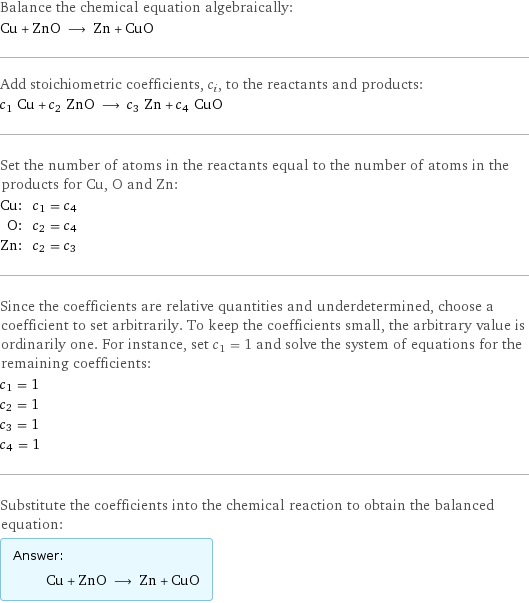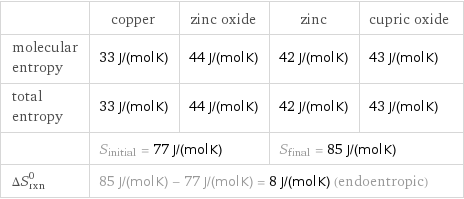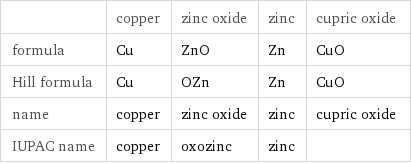Input interpretation

Cu copper + ZnO zinc oxide ⟶ Zn zinc + CuO cupric oxide
Balanced equation

Balance the chemical equation algebraically: Cu + ZnO ⟶ Zn + CuO Add stoichiometric coefficients, c_i, to the reactants and products: c_1 Cu + c_2 ZnO ⟶ c_3 Zn + c_4 CuO Set the number of atoms in the reactants equal to the number of atoms in the products for Cu, O and Zn: Cu: | c_1 = c_4 O: | c_2 = c_4 Zn: | c_2 = c_3 Since the coefficients are relative quantities and underdetermined, choose a coefficient to set arbitrarily. To keep the coefficients small, the arbitrary value is ordinarily one. For instance, set c_1 = 1 and solve the system of equations for the remaining coefficients: c_1 = 1 c_2 = 1 c_3 = 1 c_4 = 1 Substitute the coefficients into the chemical reaction to obtain the balanced equation: Answer: | | Cu + ZnO ⟶ Zn + CuO
Structures

+ ⟶ +
Names

copper + zinc oxide ⟶ zinc + cupric oxide
Reaction thermodynamics
Enthalpy

| copper | zinc oxide | zinc | cupric oxide molecular enthalpy | 0 kJ/mol | -350.5 kJ/mol | 0 kJ/mol | -157.3 kJ/mol total enthalpy | 0 kJ/mol | -350.5 kJ/mol | 0 kJ/mol | -157.3 kJ/mol | H_initial = -350.5 kJ/mol | | H_final = -157.3 kJ/mol | ΔH_rxn^0 | -157.3 kJ/mol - -350.5 kJ/mol = 193.2 kJ/mol (endothermic) | | |
Entropy

| copper | zinc oxide | zinc | cupric oxide molecular entropy | 33 J/(mol K) | 44 J/(mol K) | 42 J/(mol K) | 43 J/(mol K) total entropy | 33 J/(mol K) | 44 J/(mol K) | 42 J/(mol K) | 43 J/(mol K) | S_initial = 77 J/(mol K) | | S_final = 85 J/(mol K) | ΔS_rxn^0 | 85 J/(mol K) - 77 J/(mol K) = 8 J/(mol K) (endoentropic) | | |
Equilibrium constant
![Construct the equilibrium constant, K, expression for: Cu + ZnO ⟶ Zn + CuO Plan: • Balance the chemical equation. • Determine the stoichiometric numbers. • Assemble the activity expression for each chemical species. • Use the activity expressions to build the equilibrium constant expression. Write the balanced chemical equation: Cu + ZnO ⟶ Zn + CuO Assign stoichiometric numbers, ν_i, using the stoichiometric coefficients, c_i, from the balanced chemical equation in the following manner: ν_i = -c_i for reactants and ν_i = c_i for products: chemical species | c_i | ν_i Cu | 1 | -1 ZnO | 1 | -1 Zn | 1 | 1 CuO | 1 | 1 Assemble the activity expressions accounting for the state of matter and ν_i: chemical species | c_i | ν_i | activity expression Cu | 1 | -1 | ([Cu])^(-1) ZnO | 1 | -1 | ([ZnO])^(-1) Zn | 1 | 1 | [Zn] CuO | 1 | 1 | [CuO] The equilibrium constant symbol in the concentration basis is: K_c Mulitply the activity expressions to arrive at the K_c expression: Answer: | | K_c = ([Cu])^(-1) ([ZnO])^(-1) [Zn] [CuO] = ([Zn] [CuO])/([Cu] [ZnO])](../image_source/4eb46ed73257b5eeaddddae0a8cd01d7.png)
Construct the equilibrium constant, K, expression for: Cu + ZnO ⟶ Zn + CuO Plan: • Balance the chemical equation. • Determine the stoichiometric numbers. • Assemble the activity expression for each chemical species. • Use the activity expressions to build the equilibrium constant expression. Write the balanced chemical equation: Cu + ZnO ⟶ Zn + CuO Assign stoichiometric numbers, ν_i, using the stoichiometric coefficients, c_i, from the balanced chemical equation in the following manner: ν_i = -c_i for reactants and ν_i = c_i for products: chemical species | c_i | ν_i Cu | 1 | -1 ZnO | 1 | -1 Zn | 1 | 1 CuO | 1 | 1 Assemble the activity expressions accounting for the state of matter and ν_i: chemical species | c_i | ν_i | activity expression Cu | 1 | -1 | ([Cu])^(-1) ZnO | 1 | -1 | ([ZnO])^(-1) Zn | 1 | 1 | [Zn] CuO | 1 | 1 | [CuO] The equilibrium constant symbol in the concentration basis is: K_c Mulitply the activity expressions to arrive at the K_c expression: Answer: | | K_c = ([Cu])^(-1) ([ZnO])^(-1) [Zn] [CuO] = ([Zn] [CuO])/([Cu] [ZnO])
Rate of reaction
![Construct the rate of reaction expression for: Cu + ZnO ⟶ Zn + CuO Plan: • Balance the chemical equation. • Determine the stoichiometric numbers. • Assemble the rate term for each chemical species. • Write the rate of reaction expression. Write the balanced chemical equation: Cu + ZnO ⟶ Zn + CuO Assign stoichiometric numbers, ν_i, using the stoichiometric coefficients, c_i, from the balanced chemical equation in the following manner: ν_i = -c_i for reactants and ν_i = c_i for products: chemical species | c_i | ν_i Cu | 1 | -1 ZnO | 1 | -1 Zn | 1 | 1 CuO | 1 | 1 The rate term for each chemical species, B_i, is 1/ν_i(Δ[B_i])/(Δt) where [B_i] is the amount concentration and t is time: chemical species | c_i | ν_i | rate term Cu | 1 | -1 | -(Δ[Cu])/(Δt) ZnO | 1 | -1 | -(Δ[ZnO])/(Δt) Zn | 1 | 1 | (Δ[Zn])/(Δt) CuO | 1 | 1 | (Δ[CuO])/(Δt) (for infinitesimal rate of change, replace Δ with d) Set the rate terms equal to each other to arrive at the rate expression: Answer: | | rate = -(Δ[Cu])/(Δt) = -(Δ[ZnO])/(Δt) = (Δ[Zn])/(Δt) = (Δ[CuO])/(Δt) (assuming constant volume and no accumulation of intermediates or side products)](../image_source/5f3637a1a59e0af7634692864c9a4395.png)
Construct the rate of reaction expression for: Cu + ZnO ⟶ Zn + CuO Plan: • Balance the chemical equation. • Determine the stoichiometric numbers. • Assemble the rate term for each chemical species. • Write the rate of reaction expression. Write the balanced chemical equation: Cu + ZnO ⟶ Zn + CuO Assign stoichiometric numbers, ν_i, using the stoichiometric coefficients, c_i, from the balanced chemical equation in the following manner: ν_i = -c_i for reactants and ν_i = c_i for products: chemical species | c_i | ν_i Cu | 1 | -1 ZnO | 1 | -1 Zn | 1 | 1 CuO | 1 | 1 The rate term for each chemical species, B_i, is 1/ν_i(Δ[B_i])/(Δt) where [B_i] is the amount concentration and t is time: chemical species | c_i | ν_i | rate term Cu | 1 | -1 | -(Δ[Cu])/(Δt) ZnO | 1 | -1 | -(Δ[ZnO])/(Δt) Zn | 1 | 1 | (Δ[Zn])/(Δt) CuO | 1 | 1 | (Δ[CuO])/(Δt) (for infinitesimal rate of change, replace Δ with d) Set the rate terms equal to each other to arrive at the rate expression: Answer: | | rate = -(Δ[Cu])/(Δt) = -(Δ[ZnO])/(Δt) = (Δ[Zn])/(Δt) = (Δ[CuO])/(Δt) (assuming constant volume and no accumulation of intermediates or side products)
Chemical names and formulas

| copper | zinc oxide | zinc | cupric oxide formula | Cu | ZnO | Zn | CuO Hill formula | Cu | OZn | Zn | CuO name | copper | zinc oxide | zinc | cupric oxide IUPAC name | copper | oxozinc | zinc |
Substance properties

| copper | zinc oxide | zinc | cupric oxide molar mass | 63.546 g/mol | 81.38 g/mol | 65.38 g/mol | 79.545 g/mol phase | solid (at STP) | solid (at STP) | solid (at STP) | solid (at STP) melting point | 1083 °C | 1975 °C | 420 °C | 1326 °C boiling point | 2567 °C | 2360 °C | 907 °C | 2000 °C density | 8.96 g/cm^3 | 5.6 g/cm^3 | 7.14 g/cm^3 | 6.315 g/cm^3 solubility in water | insoluble | | insoluble | insoluble odor | odorless | odorless | odorless |
Units
